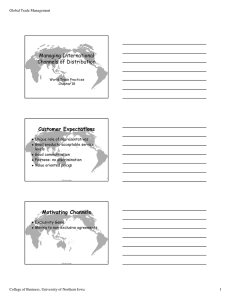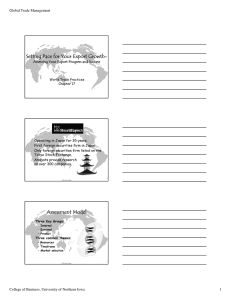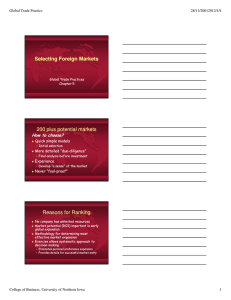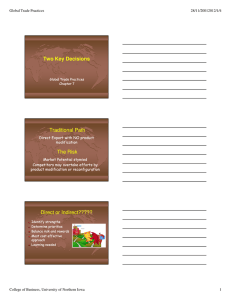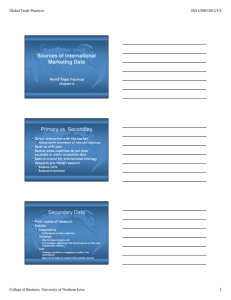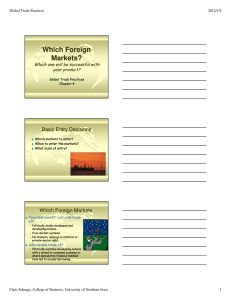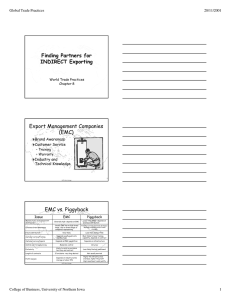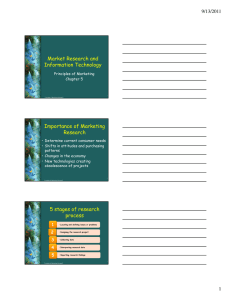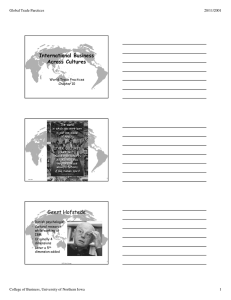Harmonized Codes Harmonized Codes-- Classifying Your Export Products
advertisement
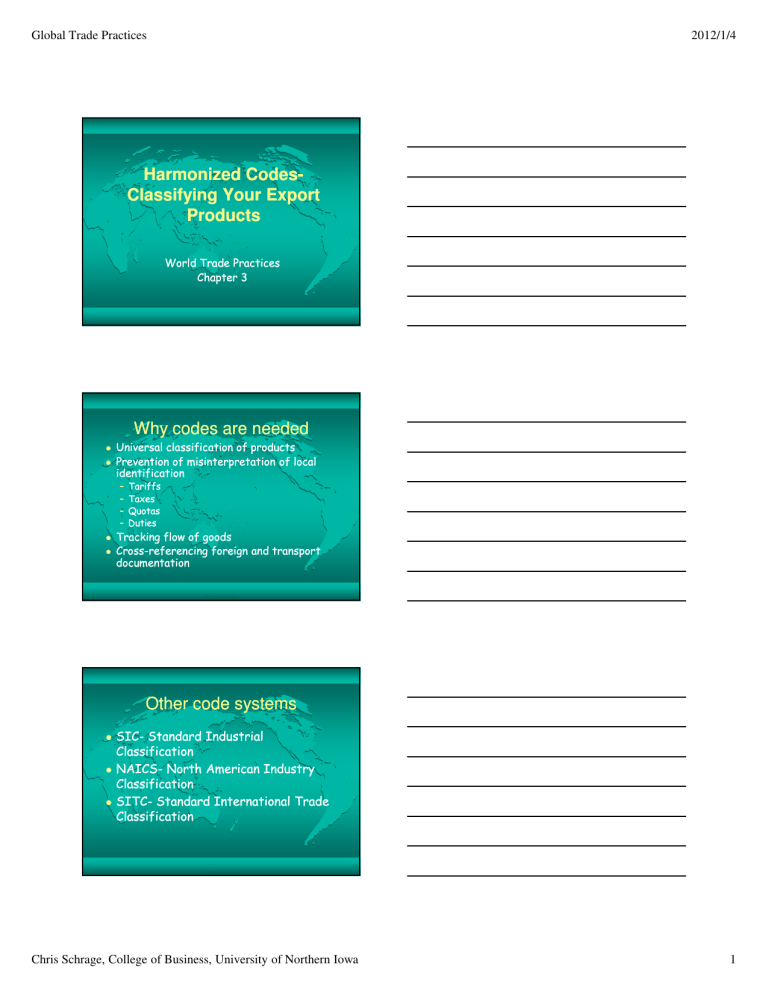
Global Trade Practices 2012/1/4 Harmonized CodesCodesClassifying Your Export Products World Trade Practices Chapter 3 Why codes are needed Universal classification of products Prevention of misinterpretation of local identification – – – – Tariffs Taxes Quotas Duties Tracking flow of goods Cross--referencing foreign and transport Cross documentation 2 WTP-Chris Schrage Other code systems SIC- Standard Industrial SICClassification NAICS-- North American Industry NAICS Classification SITC-- Standard International Trade SITC Classification 3 WTP-Chris Schrage Chris Schrage, College of Business, University of Northern Iowa 1 Global Trade Practices 2012/1/4 Commodity Codes are 10 digit numbers 0102.14.0013 Breakdown of Code 0102.14.0013 5 WTP-Chris Schrage Codes have sections and chapters 22 sections 99 chapters – Correspond to the international system of numbering – Chapter 99 is blank (catch all) 6 WTP-Chris Schrage Chris Schrage, College of Business, University of Northern Iowa 2 Global Trade Practices 2012/1/4 Headings Headings include the chapter number Generally indicate priorities of the chapter (or levels of processing) – Start at broadest category (primary products) – Becomes more defined due to condition or subset (or more complex products) Necessary to explore all headings – Example of book live animals vs. circus animals 7 WTP-Chris Schrage Subheadings Once heading defined, subheading determined Covers first 6 digits of tenten-digit code Descriptions are pretty complete In all countries that have adopted the international code, the first six digits of the 10 digit system are the same. 8 WTP-Chris Schrage Commodity Codes = Statistical Subdivisions May vary in each country Some countries may utilize 4 zeros May be just one commodity code or many Necessary to explore for each country Only the subheading is consistent 9 WTP-Chris Schrage Chris Schrage, College of Business, University of Northern Iowa 3 Global Trade Practices 2012/1/4 Commodity Code Use in the United States Importing Exporting – Harmonized Tariff – Schedule B Schedule (HTS) – Managed by U.S. Census – Managed by the Office Bureau of Tariff Affairs and – Schedule B is the actual Trade Agreements book codes are published under the U.S. International Trade in If importing and Commission exporting the same product, – Determine import duties Two harmonized codes – Track import statistics might be used. 10 WTP-Chris Schrage Locating the Correct Code Obtain copies of: – Schedule B if exporting • www.census.gov/foreign--trade/schedules/b/ www.census.gov/foreign trade/schedules/b/ – HTS if importing • http://www.usitc.gov/taffairs.htm Check the Index Both schedules can be cross referenced Difficult classification may require assistance 11 WTP-Chris Schrage General Rules of Interpretation Harmonized Tariff Schedule of the United States Updated annually Summed up in text under 6 guiding rules. 12 WTP-Chris Schrage Chris Schrage, College of Business, University of Northern Iowa 4 Global Trade Practices 2012/1/4 Six Guiding Rules 1) 2) 3) Titles of sections and chapters are only a guide Incomplete or unfinished articles are classified as if complete (assembly kits) If good can be classified under multiple headings: a) b) c) 4) 5) 6) Use most specific heading If equal descriptiondescription- use heading of major material If a or b not applicable, use last classification of merit If rules 1 to 3 inadequate, use most similar Schedule B classification Packing and ContainersContainers- typically classified with goods Rules 11-4 for the Heading, repeat process for subheading, etc. 13 WTP-Chris Schrage Seeking Assistance U.S. Census Bureau U.S. Customs U.S. International Trade Commission Local International Trade Resources Binding rulings – Free service of U.S. Customs 14 WTP-Chris Schrage Rates of Duty Column 1 GENERAL Duties for all products that do not qualify for special tariff treatment. SPECIAL Duties levels for those countries that fit into special tariff treatment programsprograms- see listing included (Example NAFTA) Column 2 Rate of duties for any products imported directly or indirectly from specific countries-- currently: countries Cuba and North Korea Chris Schrage, College of Business, University of Northern Iowa 5 Global Trade Practices 2012/1/4 Special Tariff Treatment SIC Standard Industrial Classification Now replaced by NAICS Four digit number describing activity of organization – “what it does” – May not produce a physical product for export or import – www.osha.gov/oshstats/sicser.html 17 WTP-Chris Schrage NAICS North American Industry Classification Tied to NAFTA agreement Expanded SIC code to 6 digits – Canada, Mexico, and United States – More flexibility Better comparisons between three countries’ activities than SIC www.census.gov.naics www.ntis.gov/business/sic.htm 18 WTP-Chris Schrage Chris Schrage, College of Business, University of Northern Iowa 6 Global Trade Practices 2012/1/4 SITC Standard International Trade Classification United NationsNations- 100 countries report Developed in 1950 Can be outdated information May provide general insight into trade flows 19 WTP-Chris Schrage ECCN Export Control Classification Number CT CT--PAT Patriot Act (after 99-11) Implications on what can be transported across borders 20 WTP-Chris Schrage Chris Schrage, College of Business, University of Northern Iowa 7
